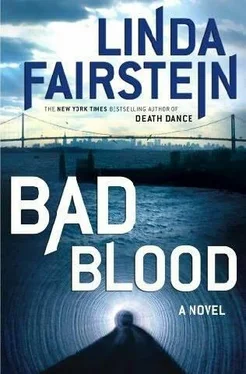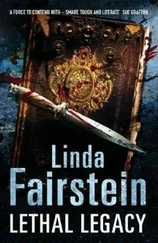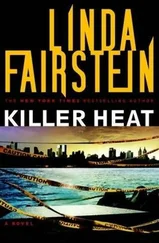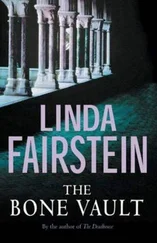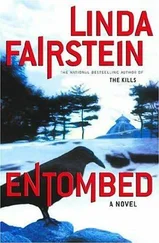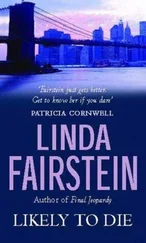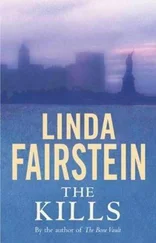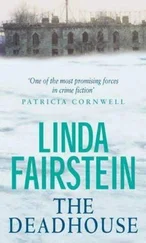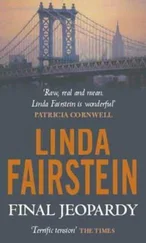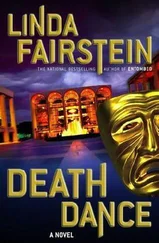Genco took his time with the answer, trying to explain the dynamic of this death mechanism without drawing an objection for any prejudicial statement. “Strangulation, you must understand, does not cause death as quickly, say, as a bullet to the brain or a stab wound to the heart. There is evidence here that despite her small stature and weight, the deceased put up a struggle-a fierce struggle-for her life.”
Several jurors began to wriggle in their seats as they followed his testimony. Genco paused, asking permission of Judge Gertz to step to the easel and refer to an enlargement of one of the autopsy photographs I had introduced through him half an hour earlier. I handed him a pointer and he got back to work.
“These marks on the neck of the deceased represent the force used by her assailant to subdue her, and then to cause her death.” He tapped at several large bruises on her throat as he spoke. “Repeated applications of force, actually, suggesting that she was struggling against him while he tried to fasten his grip more tightly. All of that fighting prolonged the process of the strangulation.”
The finger marks of the killer looked enormous to me, causing not only the external bruising but the hemorrhaging deep into the musculature that Genco’s dissection of the throat had revealed. I had studied the images for months, thinking constantly of someone with hands big enough, strong enough, to cause that damage. Someone with hands much larger than Brendan Quillian’s, which detectives had examined at the time of his arrest.
“Is there any other physical evidence to suggest that unconsciousness did not occur immediately after Mrs. Quillian was attacked?”
“Yes, Ms. Cooper. All the medical hallmarks of manual strangulation are present.”
“Would you identify those to the jury?”
Genco pointed to the small, crescent-shaped marks that bordered the larger discolorations. “Can you see these small semicircles?” he asked the jurors, most of whom were nodding. “These abrasions weren’t made by the killer. They were left there by the fingernails of the deceased herself.”
Brendan Quillian had assumed a posture of faux anguish. His shoulders were slumped and he held his head in one hand, shaking it from time to time as though incredulous that someone could have done these things to his wife.
A few jurors seemed surprised, until Genco went on with his explanation. “Mrs. Quillian was struggling against her attacker to breathe, fighting for her very life. Like every victim of strangulation whose arms aren’t bound, she tried to free her airway of the hands that were restricting it. She didn’t mean to scratch herself, but each time her assailant increased the pressure on her neck, she fought to claw his hands off her-unsuccessfully despite a number of attempts.
“This is a very slow and deliberate way to kill someone,” Genco said. His glasses were cockeyed on his nose and he adjusted them again. He looked up. “Strangulation is an especially painful way to die.”
Howell knew better than to object. The damage had been done with the forensic pathologist’s assertion, and the defense position was simply to distance Brendan Quillian from the murderous act of whatever lone thug had committed the crime. Howell leaned over to stroke his client’s back, to suggest that he needed to be comforted during this graphic description of Amanda’s death.
I took Genco through each set of fingernail scratches, hoping jurors could imagine the fourth, fifth, and sixth times that Amanda Quillian scratched at the massive pair of hands to gasp for air. I looked for their reactions out of the corner of my eye as the doctor explained the abrasion on the tip of the young woman’s chin, which he said had been injured when she lowered it in the vain effort to protect her fragile neck.
“Back to the question I asked, Doctor, about whether you can estimate the length of time you believe Mrs. Quillian fought before losing consciousness?”
“Yes, Ms. Cooper, I can. Were there constant compression of the carotid arteries, for example, one might become unconscious in fifteen or twenty seconds. But that isn’t the case here.”
Genco repeated the rest of the autopsy findings: the congestion of Amanda’s face, which had become cyanotic-tinged with a blue cast-above the site of the compression; the pinpoint hemorrhaging in the whites of her eyes and densely spread throughout the eyelids themselves; and the fracture of the hyoid bone, a horseshoe-shaped structure at the base of the tongue, crushed by the deadly reapplications of force.
“I would say that the nature and number of injuries to Mrs. Quillian’s neck and face, as well as those she sustained internally, suggest that the struggle may have lasted for as long as two or three minutes. Perhaps even four,” Genco said, looking up at the clock above the doors at the rear of the courtroom.
In my closing argument, I would repeat the medical findings and stand silently in the well of the courtroom while the second hand swept slowly around the dial four times, reminding the jurors how very long that time took to elapse. The death throes of Amanda Quillian had been excruciating, and I would make that point at every possible opportunity.
I would also have the chance, then, to suggest to them our theory that as Brendan Quillian had ordered, the enormous sapphire ring was wrenched off Amanda’s finger, and the area around the still-warm body was ransacked to create the illusion of a botched burglary. The killer had the great good fortune to be out the door and away from the town house with barely two minutes to spare before the first cops came within half a block of the scene of the crime.
I was almost at the end of Jerry Genco’s direct exam, with just a few points to clean up. The jurors and indeed the spectators seemed sobered by his testimony, following the morning’s unexpected entertainment from Kate Meade. “Did you have an opportunity to meet Brendan Quillian?”
Genco lifted the damaged eyeglass frame and focused his attention on the defendant, who sat upright and returned the stare. “Yes, I did. He came to my office the following day, October fourth.”
I didn’t bother with questions about his demeanor. I would argue that it had been part of his plan to play the grieving widower. “Did he tell you where he had been on October third?”
“Yes, he mentioned that he was in Boston. That he took the shuttle back to New York late in the evening, after Detective Chapman had notified him of the death of his wife.”
“Did you examine any part of the defendant’s face or body?”
“Yes, actually I did.”
“What were you looking for?”
Quillian’s hands were folded in front of him, resting on the counsel’s table. His fingers were long and slender, unlikely weapons in this matter, which we’d known from the outset.
“Detective Chapman and I were convinced the killer would have been injured in this struggle as well. I expected if we found him early enough, there would be lacerations-probably numerous cuts and scratches-caused by the victim’s frenzied fight for her life, on his face and hands,” Genco said, looking squarely at the defendant. “Mr. Quillian had no such injuries.”
I was about ready to relinquish my witness to Lem Howell, running my eyes down the checklist of facts that I had planned to cover on direct before I asked the judge to issue the grim photographs to the jury.
The silence occasioned by Genco’s recounting of Amanda’s last minutes alive was broken by loud voices coming from the rear of the courtroom. As with all high-profile trials in Manhattan, every seat in the house was filled, and a line of onlookers queued in the hallway to fill the place of any departing spectator.
The lone court officer in charge of the flow was pushing and shoving a tall, pale-faced man in a blue seersucker suit who was trying to break past him.
Читать дальше
